(2017/09/04 Note: this post does not have my latest thinking on making the best French macarons possible. I encourage you to, instead, follow the instructions in this post where I compare, head-to-head, the macaron recipes of the world’s top pastry chefs.)
This is a tutorial for French macarons (also known as macarons), not for macaroons. Macarons are delicate French pastries that come in hundreds of flavours and colours while macaroons are made from dessicated coconut and come in regular and chocolate, and that’s about it. Macaron is pronounced [MAC-a-ron] while macaroon is pronounced [mac-a-RUNE]. Roll your Rs (and speak with a French accent) for the former. If you want some macaron recipes, please check out my recipe index! Macarons are great for eating by themselves or, if you want to be fancy, make a great decoration for entremets. So, let’s get started!
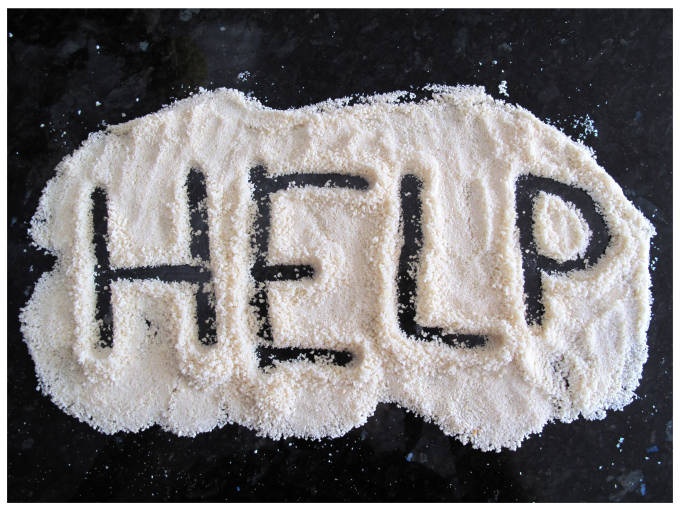 There are thousands of recipes online for macarons, all slightly different. The problem is a lot of them aren’t very clear. Since macarons are very delicate, it’s important to have excellent technique. That’s hard to do though when recipes tell you to do things like fold the batter until it looks like “magma”. Seriously? Magma? Underground lava? That’s helpful.
There are thousands of recipes online for macarons, all slightly different. The problem is a lot of them aren’t very clear. Since macarons are very delicate, it’s important to have excellent technique. That’s hard to do though when recipes tell you to do things like fold the batter until it looks like “magma”. Seriously? Magma? Underground lava? That’s helpful.
I combined tips and tricks from dozens of sources to write this guide. I’ve tested so many different macaron recipes but this is the only one that gives me consistent results. It’s based mainly off of Stella’s (from BraveTart) recipe, but does have some changes from other sources that I find work better for me.
The first step is to make 4oz (115g) of ground, blanched almonds (or any nut, really). You can either buy ground almonds, blanched almonds, or plain almonds. If you choose to buy plain almonds, you need to blanch them. Do this by pouring boiling water over the almonds and letting them sit for a minute. Then, pour cold water over the almonds. You should be able to then peel the skins off with your fingers.
At this point, whether you use ground almonds or blanched almonds, you need to grind them in a food processor or “chopper” with 8oz (230g) of powdered/icing sugar. Even if your almonds are already ground/powdered, this will ensure the almonds are evenly dispersed in the powdered sugar. To get the best results possible, I suggest layering the powdered sugar and almonds before grinding.
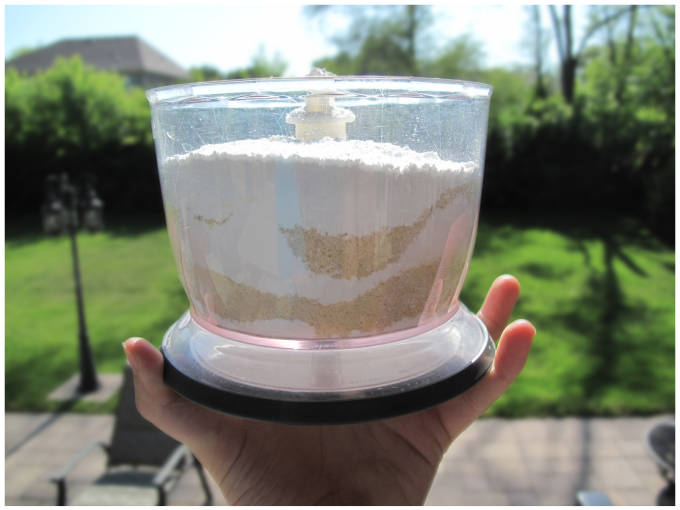 Then, grind, grind, grind! Grind for about a minute (if you’re using pre-ground almonds) to three or four minutes (if you’re using blanched almonds). After that, dump everything out.
Then, grind, grind, grind! Grind for about a minute (if you’re using pre-ground almonds) to three or four minutes (if you’re using blanched almonds). After that, dump everything out.
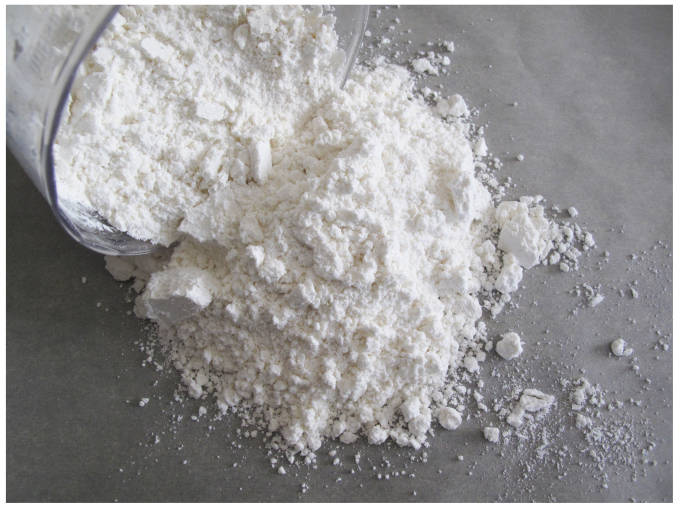 The next step is to sift everything. Macarons are very delicate so when there are clumps of almonds and powdered sugar in them they have a weird texture. Also, when you have clumps, it promotes cracking in the shells.
The next step is to sift everything. Macarons are very delicate so when there are clumps of almonds and powdered sugar in them they have a weird texture. Also, when you have clumps, it promotes cracking in the shells.
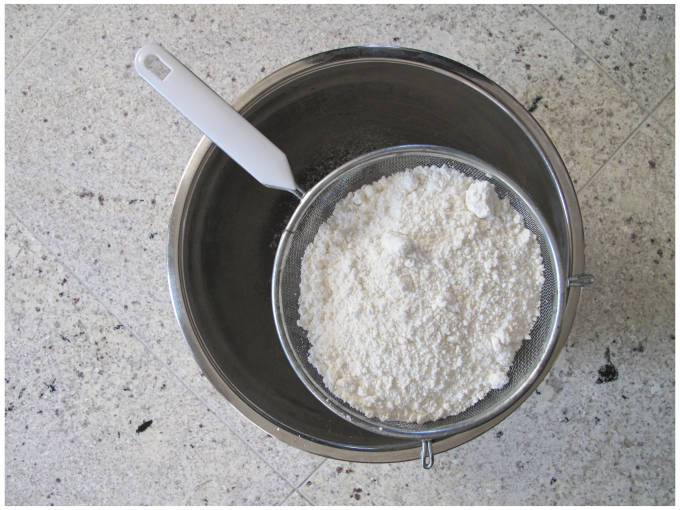 After you sift everything, they’ll be some larger pieces left. Grind those for about a minute and then sift them in. You’ll still have about two tablespoons left of larger pieces. Throw them out. Don’t risk the shells cracking by putting them in.
After you sift everything, they’ll be some larger pieces left. Grind those for about a minute and then sift them in. You’ll still have about two tablespoons left of larger pieces. Throw them out. Don’t risk the shells cracking by putting them in.
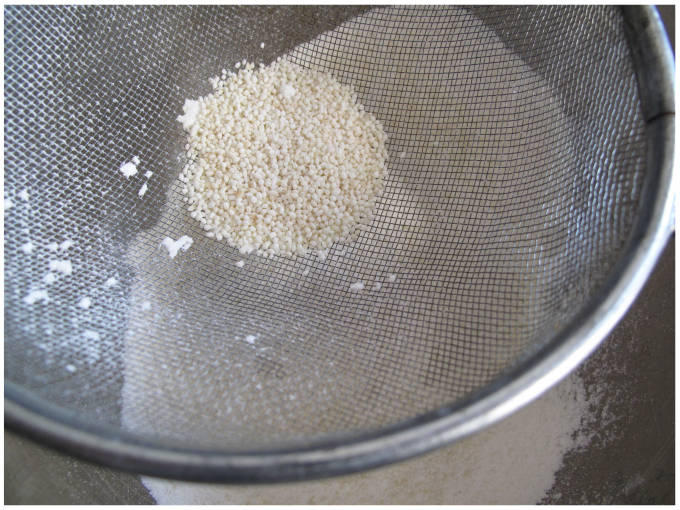 The next step is to combine 5oz (144g) of egg whites, 2 1/2oz (72g) of sugar, 1/2 teaspoon (2g) of salt, and the seeds of one vanilla bean. First off, it doesn’t matter what temperature or how old the egg whites are. I just grab the eggs out of the fridge and use them. Seriously. It doesn’t matter. Also, you may find it strange that you’re adding in all the sugar at once, but also, it doesn’t matter. If you don’t have a vanilla bean, you can use vanilla extract (2 teaspoons). If you choose to use vanilla extract, don’t add it in just yet.
The next step is to combine 5oz (144g) of egg whites, 2 1/2oz (72g) of sugar, 1/2 teaspoon (2g) of salt, and the seeds of one vanilla bean. First off, it doesn’t matter what temperature or how old the egg whites are. I just grab the eggs out of the fridge and use them. Seriously. It doesn’t matter. Also, you may find it strange that you’re adding in all the sugar at once, but also, it doesn’t matter. If you don’t have a vanilla bean, you can use vanilla extract (2 teaspoons). If you choose to use vanilla extract, don’t add it in just yet.
You’ll want to beat this mixture until the egg whites are frothy, about three minutes on speed four on a Kitchenaid stand mixer.
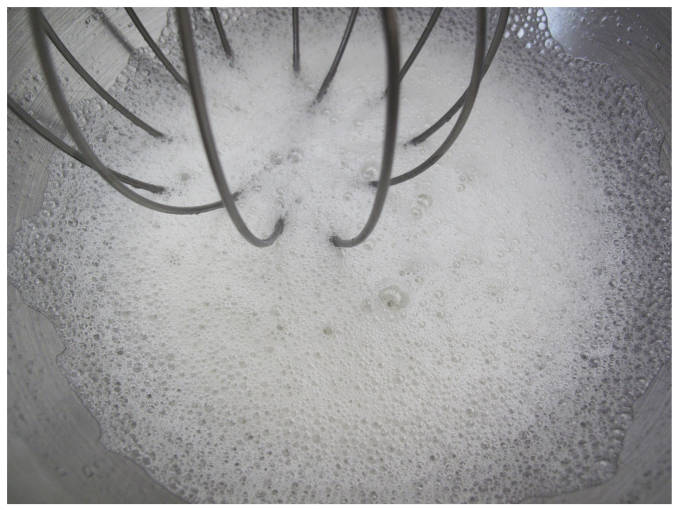 Then, turn up the speed to seven and whip for another three minutes. This will get you to soft peaks.
Then, turn up the speed to seven and whip for another three minutes. This will get you to soft peaks.
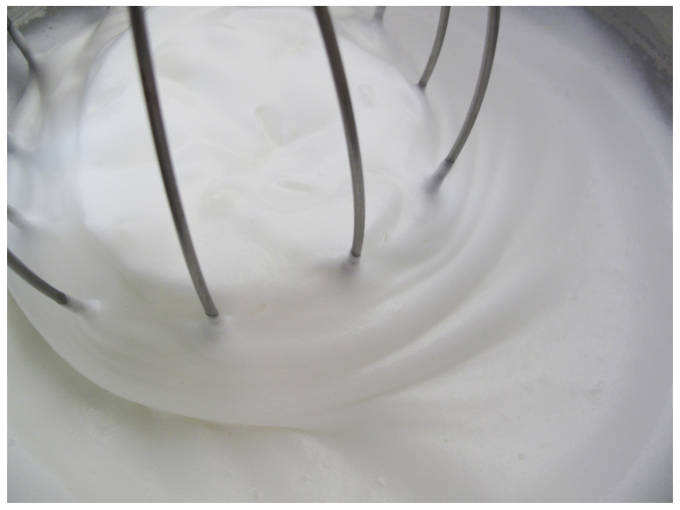 Turn up the speed to eight and beat for another three minutes. This will get you to stiff, dry peaks. This is different from a lot of recipes but it works. It really works. In fact, the results are more consistent if you do this. So do it. Trust me.
Turn up the speed to eight and beat for another three minutes. This will get you to stiff, dry peaks. This is different from a lot of recipes but it works. It really works. In fact, the results are more consistent if you do this. So do it. Trust me.
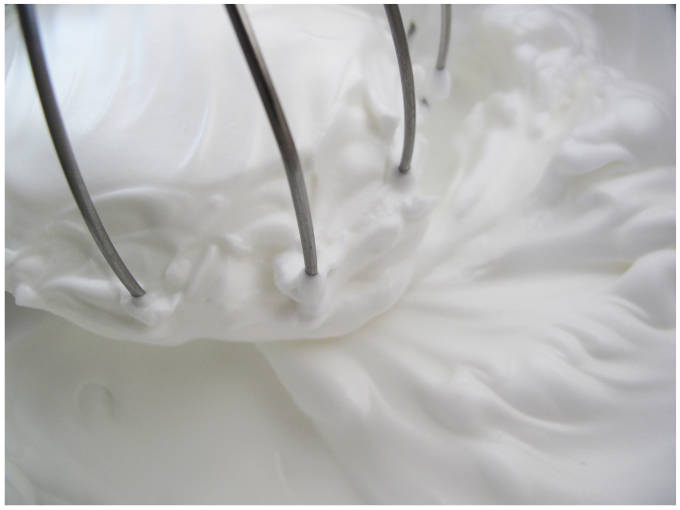 At this point add in any colouring and flavouring. If you’re using vanilla extract, add it in now. For food colouring, I highly suggest using powdered food colouring. If you don’t have any, then use some good gel food colouring. Avoid using liquid food colouring as it will ruin the texture of your macarons. The colour that you use will fade in the oven (especially Wilton gels). I didn’t add a lot of colour to mine because I prefer pastel-shades, but by all means add more colour if you so desire. Beat on the highest speed (ten) for one minute to incorporate all the colouring and flavouring. Here, I added some red gel food colouring and 1 1/2 teaspoons of rose water to make rose-flavoured macarons.
At this point add in any colouring and flavouring. If you’re using vanilla extract, add it in now. For food colouring, I highly suggest using powdered food colouring. If you don’t have any, then use some good gel food colouring. Avoid using liquid food colouring as it will ruin the texture of your macarons. The colour that you use will fade in the oven (especially Wilton gels). I didn’t add a lot of colour to mine because I prefer pastel-shades, but by all means add more colour if you so desire. Beat on the highest speed (ten) for one minute to incorporate all the colouring and flavouring. Here, I added some red gel food colouring and 1 1/2 teaspoons of rose water to make rose-flavoured macarons.
When you take your whisk-head-attachment-thing out there should be a big clump of egg whites stuck inside. If there isn’t, keep on beating until there is.
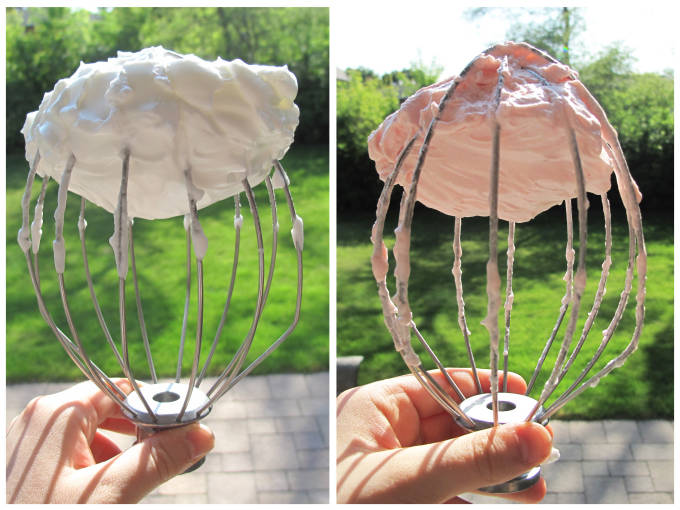 At this point, hit the whisk against the side of the bowl so that the egg whites fall out. Take all your almond mixture and put in. All of it. At once. Don’t add a little bit at a time. It’s so much more effort and doesn’t do anything. At this point we’re starting “macaronage” which is a French word meaning the process of incorporating the dry ingredients with the egg whites to make macarons.
At this point, hit the whisk against the side of the bowl so that the egg whites fall out. Take all your almond mixture and put in. All of it. At once. Don’t add a little bit at a time. It’s so much more effort and doesn’t do anything. At this point we’re starting “macaronage” which is a French word meaning the process of incorporating the dry ingredients with the egg whites to make macarons.
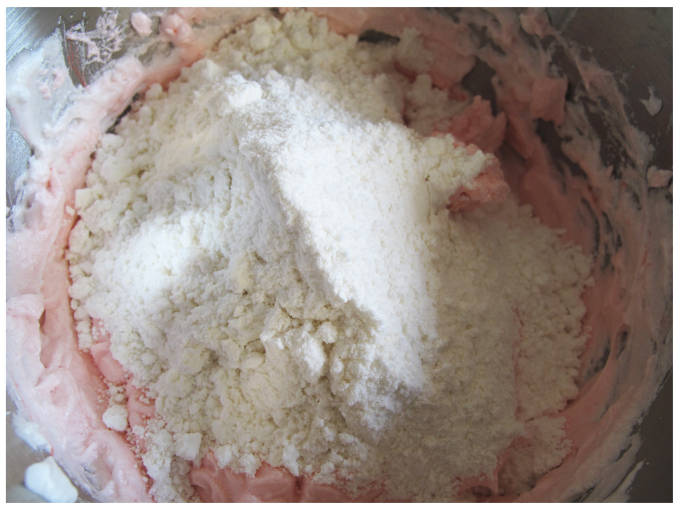 Alright, here’s where it gets tricky. You need to deflate the egg whites to a certain point. Using both a folding motion to incorporate the dry ingredients, and a pressing motion against the side of the bowl, you’re trying to get the batter to the right consistency. But what is the right consistency? Some recommend getting the batter to look like magma, but that doesn’t really help me. You should keep on folding and deflating until the point when you can take a teaspoon of the batter and drop it on a plate and the peak that was formed flattens in ten seconds. I find that doing that test gives me the most accurate results. Be careful not to over mix. Test your batter every few strokes. Be sure to use a spatula for this process – a whisk will not work.
Alright, here’s where it gets tricky. You need to deflate the egg whites to a certain point. Using both a folding motion to incorporate the dry ingredients, and a pressing motion against the side of the bowl, you’re trying to get the batter to the right consistency. But what is the right consistency? Some recommend getting the batter to look like magma, but that doesn’t really help me. You should keep on folding and deflating until the point when you can take a teaspoon of the batter and drop it on a plate and the peak that was formed flattens in ten seconds. I find that doing that test gives me the most accurate results. Be careful not to over mix. Test your batter every few strokes. Be sure to use a spatula for this process – a whisk will not work.
After a few strokes it should look hopeless. Like so:
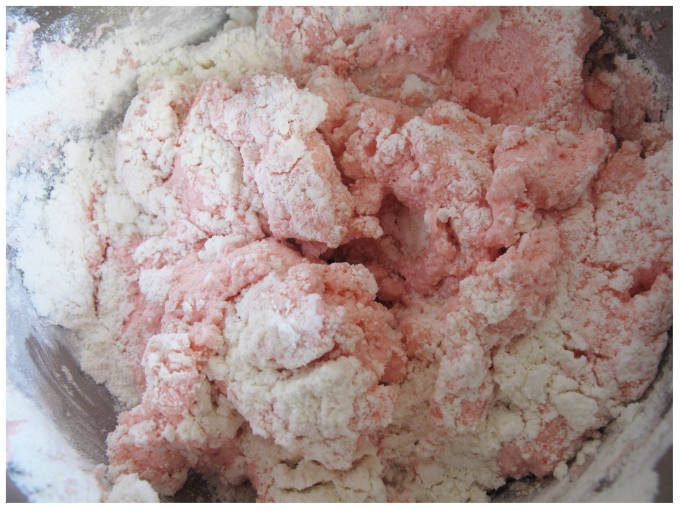
And then, after a few strokes, it should look a bit better.
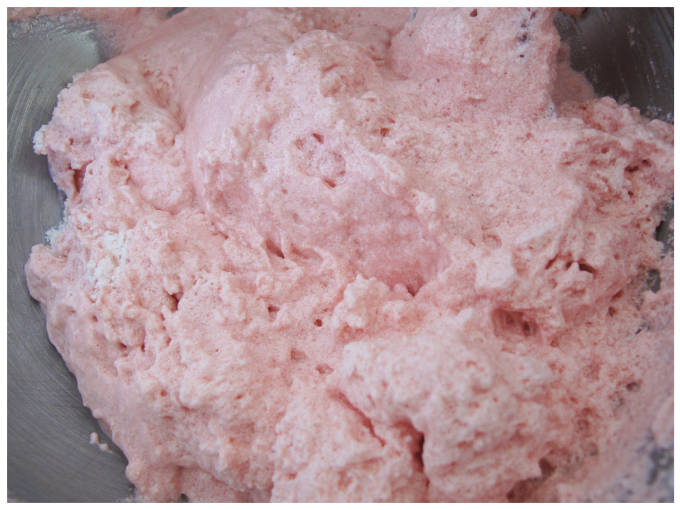
Almost there! Keep on folding!
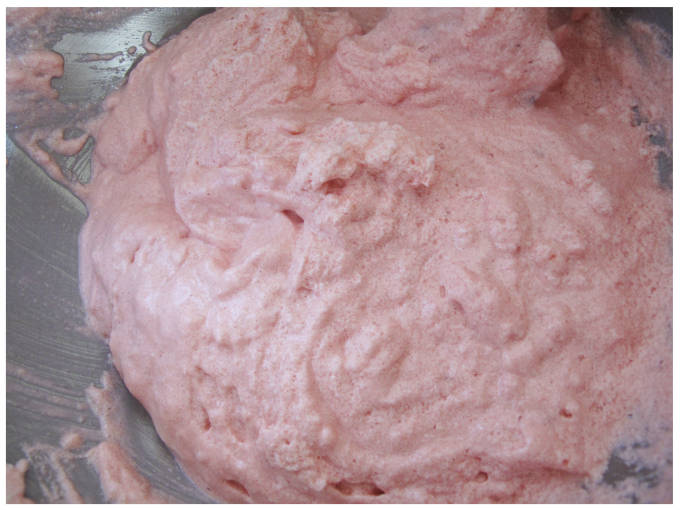
Finally, you’re done.
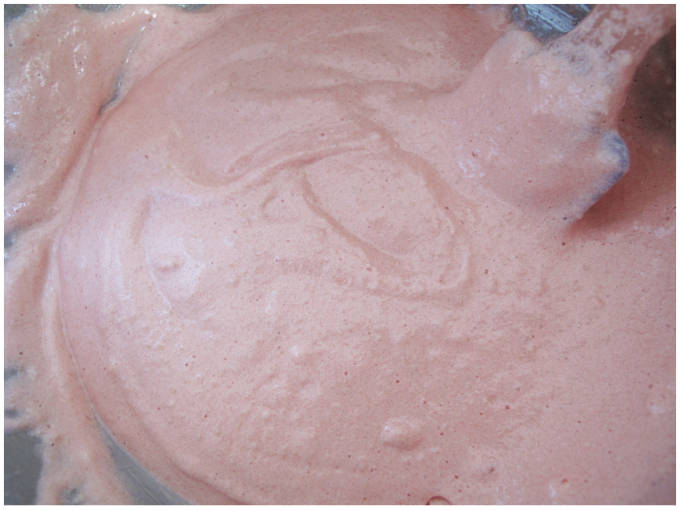
Take a piping bag fitted with really any single-opening tip and fill it up halfway. On a baking pan lined with parchment paper (which I find works better than a Silpat baking mat) pipe the macarons by holding your bag at a 45-degree angle to the paper. Press down on the bag for about 2-5 seconds (depending on the size of your tip and how hard you press) until a circle forms. Pick up the bag, and keep on going.
Once you finish piping, pick up the baking sheet and hit it against the table a few times to dislodge any trapped air bubbles.
The piped macarons need to dry out until the tops of shells aren’t sticky. This might take as long as 1 1/2 hours. When you touch the top of the shell, no batter should stick to your finger. In the picture below, you can see some macarons that failed the “drying-test”.
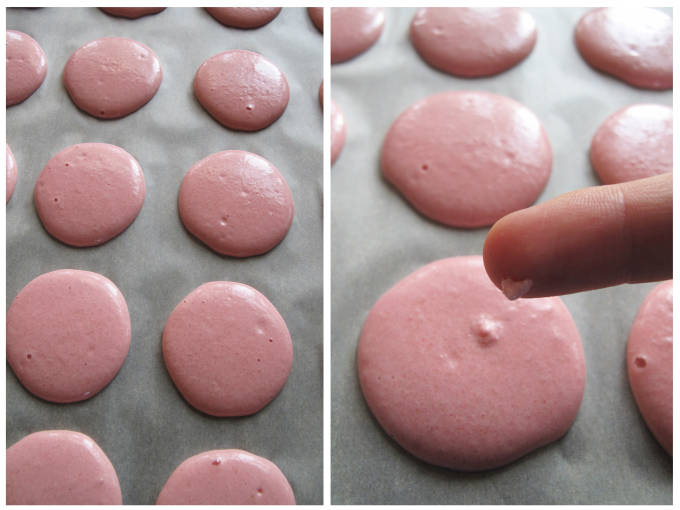 I know some recipes say not to dry out the shells but it really helps. Successfully baked macarons have “feet”. Feet are a layer of bubble-like things at the bottom of a macaron shell. They form when the air that is in the batter is forced down. If the shell is not dry, the air will leave through the top and cracks will form. If the shell is dry, the air will have trouble escaping from the top and push down, creating feet. While the shells are drying, preheat your oven to 300°F. I recommend using the convection bake setting if you have it. I highly recommend stacking your baking sheets. Once the shells finish drying, bake for about ten-twenty minutes or until the shells come off the parchment paper without their centres sticking.
I know some recipes say not to dry out the shells but it really helps. Successfully baked macarons have “feet”. Feet are a layer of bubble-like things at the bottom of a macaron shell. They form when the air that is in the batter is forced down. If the shell is not dry, the air will leave through the top and cracks will form. If the shell is dry, the air will have trouble escaping from the top and push down, creating feet. While the shells are drying, preheat your oven to 300°F. I recommend using the convection bake setting if you have it. I highly recommend stacking your baking sheets. Once the shells finish drying, bake for about ten-twenty minutes or until the shells come off the parchment paper without their centres sticking.
Let the shells cool on the pan and then remove them. Pipe buttercream, ganache, jam, or whatever you’d like (as long as it’s not too liquidy like honey) on half the shells and then sandwich the shells together. For these, I used coconut rum buttercream that I made by adding coconut rum, which I boiled down, to Swiss meringue buttercream. Let the macarons age in the fridge for twenty-four hours before eating. Let the “cookies” come to room temperature before digging in.
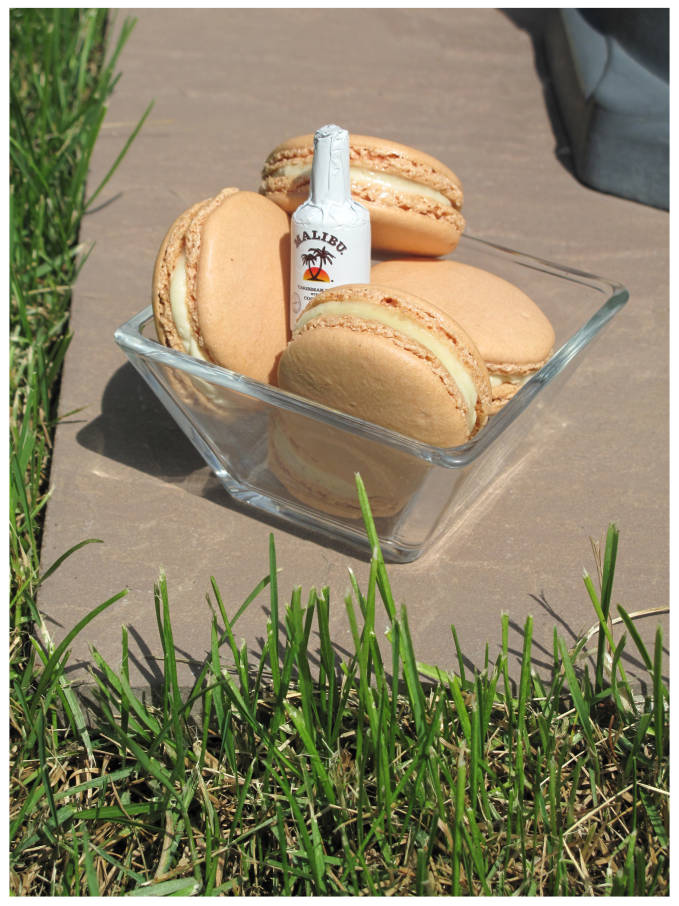
If you’re not in the mood for rose macarons with coconut rum filling, click here to discover other macaron flavours!
If you have any questions, feel free to leave a comment and I’ll get back to you as soon as I can.
P.S. Thanks again Stella for all the help!
(2017/09/04 Note: this post does not have my latest thinking on making the best French macarons possible. I encourage you to, instead, follow the instructions in this post where I compare, head-to-head, the macaron recipes of the world’s top pastry chefs.)
Liked this tutorial? Read another one!
Holy Moly, this tutorial is awesome!!! I can’t wait to give macarons another try now that I have this awesome help! :)
Those macarons look delicious!
My sister wants to learn how to make Macarons, so I sent this along to her! Hopefully she has as nice-looking results as you do!
This tutorial is fantastic! I will have to make some, now that I know the tips and tricks of them! Now, what flavour… Decisions, decisions, decisions…
amazing tutorial <3
My friend and I are making your recipe. Does the weather or humidity make a difference when making macarons?
A lot of people say it does but I don’t think so. Let me know how it goes! :)
I really like how easy this recipe was to follow for my first time making Macarons but I still fail. I used powder coloring but when I baked them the color faded, they had brown corners and the inside was still soft when I tried picking one up while it was hot.
What would make my macarons pucker? Barbara
I’m not really sure what you mean by pucker. Would you rephrase please?
the macarons started to invert and then they just fell. a horrible failure. it seems like the chocolate ones are more temperamental. What do you do when you have to bake them for an occasion and it is raining? can you turn the air conditioning on high? will that help?
When you piped them did they spread a lot or did they stay generally the same size? How did you make the chocolate ones? Turning on the air conditioner might help, but I find that for me the amount of humidity doesn’t really change much.
I’ve been so scared to try making macarons and they are my absolute favourite treat! I saw this post and I’m definitely going to bookmark and one day, when I’m brave enough (haha) I will definitely follow all your instructions and tips and hope for the best!
Hi
Since my stand mixer broke n all I have left is my hand mixer n I have to make some for a project how do you know when to stop beating your egg whites with a hand mixer?
I would suggest going until you get really dry, stiff peaks like in the photo then instead of going by times.
Thanks for the wonderful tutorial. I made a couple seemingly perfect batches of macarons last weekend. I stored them airtight in the fridge for about 24 hours, and when I took them out, I noticed that some of them were starting to “weep,” (leaving moisture on the bottom shell), some were softening to the point that they started to disintegrate — and did!
I don’t think it was the baking process as the macarons were fully cooked (steady on their feet) with no hollows when I took them out. I used a pastry cream filling that is taught by La Cuisine Paris cooking school in Paris. Could my fridge be too cold or not cold enough? I would love your thoughts on how to fix this. Maybe just skip the fridge?
I’m thinking that the issue might be the pastry cream. Sometimes pastry cream separates and a liquid forms. I think that may have soaked your shells.
Hi, Ilan, a Chowhounder referred me to your site when I posted a question about how to make some tersely-written recipes that use ground up nuts, sugar and egg whites, but offer little to nothing by way of baking instructions. Most of the recipes I’d asked about use equal parts ground almonds (or hazelnuts) and sugar, so they’ll be denser than your macarons. The batter is poured into moulds or cake pans. Do you think I should still use the folding-and-flattening technique you show us, or should I just carefully fold the beaten egg whites into the sugar+nut paste? And should I use the same baking time and temperature as for your macarons (where a heat is indicated, it’s only given as “four doux”)? What is your scientific opinion? :-)
If you don’t deflate the egg whites at all (i.e. if you’re very careful) then there will be bubbles in your macarons and they may crack. I also don’t suggest putting them in moulds because macarons need to rise up, giving them feet at the bottom. If you put them in moulds not only will the macaron cook strangely (temperature wise) but you’ll get a weird shaped mac with feet at the bottom perhaps. If you’re looking for specific recipes I think it makes more sense to use specific temperatures, no?
I tried to make a batch today, but ti seems like no matter how long i let it sit to let it dry, it still fails. It’s been sitting for almost 2 hours. Any advice?
update: even after 5 hours it’s still not dry. I followed the instructions above step by step and made sure it looked like the pictures as well.
Did you make sure that you beat to stiff, dry peaks and not just stiff peaks? Also it’s not that the entire macaron has to be dry, just the top. It’s just that none should really stick to your finger when you gently put your finger on the macaron. If your kitchen is very humid it would affect drying time. If it’s still not working out, then the only thing you can do is bake them as is, right?
I did beat it to stiff dry peaks, but still for some reason the top never dried up. The kitchen was pretty humid and cold, I guess i’ll keep trying until it comes out as nice as the ones in your tutorial.
What happened when you baked them? Did they have feet?
Same thing happened to me. After 21/2 hours still not dry. I baked a batch. They were flat and it took about 30 minutes to bake with a convection oven. So the 2nd batch continued to dry without success. That batch turned out flat too. They taste okay. Maybe I will eat them with ice cream
I have one of those old conventional ovens that doesn’t have a fan inside, can you tell me what temperature i should set the oven to and how long to bake the macarons? I tried 325 degrees for 20 minutes, but the edges seem to get a little burnt. Also should i use a silicon sheet and double tray when baking?
If you don’t have a fan setting just make them without it. The amount that you bake them depends on the colour. If you’re using a lighter colour, bake for less time.
I got the macaroons to come out, but for some reason it is hard and the inside is full on hollow. what should i change to get the shell to be not as thick and get the inside to be light and fluffy liek the macaroons that I bought at a store to compare mine with?
It sounds like you either over baked them or you over mixed the nuts with the egg whites. It’s probably the latter. Try mixing them for a shorter period of time.
Hi! Your tutorial looks great! I’d like to try it out, but can I just substitute the ground blanched almonds with almond flour? And how many macarons does this recipe make? Thanks!
Hi Jessica! You can definitely substitute ground almonds for almond flour. Almond flour is just blanched almonds that are ground up. The recipe makes about two dozen. Let me know how it goes!
What brand was the powder food coloring and where did you buy it?
I just used some random brand of food colouring that I found in a corner pakistani grocery store. Just got lucky. You may want to order online, or go to a specialty baking store.
Hi great tutorial :D im following Stella’s recipe too but she says not to dry the macaron’s. Is your recipe different in so that the macarons will dry or should I just dry my macarons that have been made by stella’s recipe?? Thank you for your help :D much love x x xx
Hi Courtney, my recipe has a few small changes to Stella’s. I find that drying is a very important step in macaron making.
What am I doing wrong if after piping the mixture spreads out a lot, and the shells come out flat and with no feet?
Hi Jared, you’re overfolding the mixture. It should not be so runny.
thanks for the quick reply! any way to salvage the mixture?
Unfortunately not.
I did everything mentioned here…yet they rose, got burnt around the edges slightly and then fell flat! This is the 5th time I’m trying…I don’t know where I am going wrong!
Shruti, it sounds like you overfolded the batter. Did they spread a lot after piping?
Nope just a little like how it’s supposed to in the countless videos that I’ve seen. Anyway, I think I figured out the problem…in India, especially in the monsoon, the weather is just impossible so I guess I will have to try in winter!
If you’re in a super humid environment, you should let your egg whites dry out overnight in a container on the counter. Not letting them dry out is OK only if your kitchen isn’t humid.
Made my first trial batch of macaroons today and they weren’t too bad. But the colour was a disaster! I have to make some deep purple ones (wedding colour theme)! They went into the oven as a beautiful shade of deep lilac – but came out grey/beige. The insides were ok but no-one is going to see those till they bite. I used a gel paste product and used a Mastrad macaroon mat to bake. Can you help PLEASE?
Hi Jan, it sounds like your problem is that you’re not using a heat-safe food colouring. These food colouring look vibrant until they’re put in the oven. Wilton is an example of one. Try using a powdered food colouring – those give the best results.
Hi – My batches are showing beautiful feet but hard tops though not hollow. You’ve suggested the problem may be over cooking or over mixing. I’m trying to be mindful of the temperature/time ratio and my batter consistency was like ‘molten lava’, but still hard tops. Suggestions? Thanks.
Hi Leslie, first of all sorry for the super late reply. Your problem might be that the top heating element is cooking the tops of the macarons too quickly. Try moving them down a rack or placing a tray between the macarons and the top heating element. This is, of course, only if the shells are hard after resting for a day in the fridge with the filling.
Best tutorial ever! I’m on my third round of macaron-ing. I’m feeling good about the fourth!
Hi, I tried making sea salt caramel macarons. I followed your tutorial, but I upped the salt content in the macaron recipe by 1 teaspoon. Needless to say it was an absolute failure. I thought I had gotten stiff peaks, and hadn’t over-deflated the egg whites, but nevertheless the macarons were flat, and ran during baking (looking more like a flat cookie, no rise). Could the salt content have affected the baking process?
Hi Shireen, I think the salt might be part of the problem. I accidentally added too much powdered food colouring (which contains salt) to macarons once and they came out quite flat. I would suggest adding any flavourings to the filling rather than the shell.
I’ve been making macarons fine for a little while now. Then the last 2 weeks I can’t seem to get it right.
Basically same recipe and technique except I’ve been using ck powder coloring instead of my usual gels.
My last few trays of macarons crack/blister on top and are feet less. The edges aren’t puffed but somewhat flat. Naturally I thought this was maybe because I undermixed and the heat was too high. So I tried temperatures ranging from 280-315. And in one batch I over mixed slightly. All pretty much the same results. And all dried from 30-80 minutes till no longer tacky.
Do you have any suggestions or ideas on what’s causing this? I’m really stumped.
Hey Julie, thanks for your question! When using a gel you are adding moisture to the recipe. When you switch to powdered colouring, you are no longer adding moisture. The idea then is to increase moisture in your macarons without using gels (if you want to use powdered colours). You can increase moisture in macarons by either (a) beating the egg whites for less time, or (b) drying them out for less time if you are in the first place. Good luck!
Thanks for your quick reply!!
I just finished another batch but lowered the temp even more and placed an empty tray in the rack below it.
First tray cracked, second tray decent but lopsided, last was all over the place.
Haha I’m so confused now. I think I’m going to start from the beginning now and test each variation.
Thanks again!
Hi, thanks for this helpful guide! I was wondering why you don’t have to dry out the egg whites or age them. I have seen them dried and aged in many recipes and want to know why you didn’t do it here. Thanks!
Hi Anna! The idea behind drying out the egg whites is to decrease the moisture in the macarons. I decreased the moisture by beating the egg whites for longer than in most recipe instead. Good luck!
I tried a batch yesterday. Many of them cracked, so I assume that I need to mix them a bit better and dry them longer. I also don’t remember them being so soft? How fragile are the shells when made correctly?
Hi Ami, yup, that sounds about right. Also try using a slightly lower temperature for baking. They shouldn’t be very soft. If they are too soft there is probably too much liquid in your filling. Are they soft out of the oven, or after resting?
Hi Iian.
This is a truly AB/FAB blog/tutorial.
I am in the process of trying to master the art of making these little blighters – so far the results have been less than spectacular! However, I refuse to be beaten by 3 egg whites (sorry!) and a few ounces of almond meal, so I will press on regardless.
Now I have read the above Ab/FAB tutorial but confess to not having read all of the comments/questions that followed, so it’s possible that my question has already been asked but nevertheless, I will press on.
Most of the ground almonds that I buy are quite oily and I want to know what is the best way to dry them out? I read on one site that you should spread them on to a baking sheet and put them in the oven on 200f/95c for half an hour. Does that sound about right to you?
Do you have any other suggestions for drying them out?
Look forward to hearing from you,
Pattie
Hi Pattie! Have you tried grinding your own blanched almonds? Or perhaps blanching your own almonds and grinding them? That way you can control how oily they are (by grinding them for less time). That’s probably the best way to fix the problem.
I really like this tutorial!! I made macarons, but mine didn’t have any feet :( What should I do???
Hi Stacey! Yes, the expectation is that the macarons have “feet”, but unfortunately yours do not. However, they they can be improved! Next time, do not deflate your batter as much while mixing and you should be all set. Happy baking.
Hey Ilan, I made my about 5th batch of Macarons and they have turned out fairly mixed. This one is the first one with an electric beater, I had to do it by hand before that.
I was hoping that you can maybe tell me what you think of the batter consistency. I purposly mixed it a bit less, it doesnt really flow well but it seems to reincorporate well and the peaks disappear soon after. The other times I mixed it more and I believe it was too much. They were too big and flat for my taste though most of them didn’t crack.
With this batch I had a few cracked ones, a few without feet but the rest was great. They had some browning, too even though I covered the top with another pan.
Anyway, onbviously I will try again soon but if it doesn’t work out soon I think I will have to try out the italian methode ;)
Also, I appologise for the music–
here is the picture of the cooked macarons.
http://hpics.li/f9cae51
Here it the video: http://www.youtube.com/watch?v=sj5KqW2hAFg
Thanks :) And now that I finally have a cheap beater I want to start making entremets, too just need to buy a cola-can to make a few rings
Sorry, forgot to add this picture of the piped macarons. http://hpics.li/d366e76
Sorry for the late reply Leon! Your batter consistency looks pretty good. I think that the cracking and browning was because of uneven heating in your oven. In my oven, I can only put the macarons on a specific section of the pan or else they crack. Entremets are so much fun! Good luck :)
Hi!!! I’ve been trying to perfect my macaron recipe and every time I do I get hard, crumbly tops and not the wonderful chewy, light and fluffy texture. Is there something I should change in the recipe or the temperature or baking time?
Definitely! Try lowering the oven temperature slightly and placing a baking pan between the top heating element and the macarons. Using a convection bake setting might help too. Let me know!
i don’t have a food processor! what am i going to do with the ground almond!!?????
You can buy ground almonds in the store and sift them with the icing sugar. Good luck! :)
OMG How come did I just find out about your blog now?! Love your posts!!! I am such an amateur at baking (and cooking) but I want to try making macarons! LOL Before I attempt them, I have a several of questions..
My oven is extremely hot and sometimes doesn’t match the temp listed in a recipe (it’s too hot). How can I test that the macarons are done before I over bake them? Take them out and lightly press them? They should ‘spring back’ … idk. I saw that ‘tip’ in another recipe. Also, when you bake them, do you have to rotate the sheets? I have the regular and convection bake setting. How do you get the macarons to be very pigmented in colour? Like the matcha green tea macarons you made.. that 1 tbsp of matcha made it THAT green?! What’s the difference between dry stiff peaks and regular stiff peaks?
I’ve been reading SO MANY recipes but, like you said, they all vary every so slightly that idk which one to choose… I’m going to use yours.
:)
Hi Sally!
If your oven is too hot, you should use an oven thermometer to adjust it to the correct temperature. It’s hard to tell once they’re done, aside from experience. Pressing on them can crack them too easily. I don’t rotate the sheets, but depending on your oven you may need to. I used green powdered food colouring. Dry stiff peaks are beaten a little bit more so they aren’t as shiny.
Hope that helps. Sorry for the super late reply.
*bake for about ten-twenty minutes
Is there more precise temp? like within 5 mins. This sounds like I have to test for a few to get to the closest timing.
Hi Emma, it depends on the colour you use and the add ins you put in, so there’s no specific time. Also depends on your oven.
Hi Ilan,
I had my macarons drying out for 5 hours and it was dry but not 100% (some of the batter would still stick to my finger) What I did was placing it under the convectional oven to dry and when I touched it, it no longer left any residue on my fingers. But here’s the problem.
After I’ve baked them, there is no feet! ): It was really disappointing.. Any chance you know what the problem might be?
Hey Cera,
I suggest that you check out the new macaron recipe I’ve been playing around with over here. They should dry out better. I think that leaving it in the oven to dry out may have been part of the problem.
Ilan
Thanks for the great tutorial. I have been making macarons for about 6 months now. My only problem is with the color. As you mentioned, the gel fades when baking. I bought a small jar of powdered color and I thought I put in a good amount and there was hardly any color. I added the powdered coloring to the sifted almond flour/powdered sugar mixture prior to macronage. Do you have any suggestions? Also, maybe the powdered coloring I bought wasn’t good. Is there a brand/website you recommend for the powdered coloring?
Hey Allison, I use lots of different brands of powdered food colouring and they all work pretty much the same. I don’t think the problem is with the food colouring though. Your problem is with how you add it. It should be beaten into the egg whites, after they get to the right stage, and not into the dry ingredients. Then, fold in the dry ingredients and do macaronage. Try that.
Thanks, I will try that. I had previously read that gel food coloring is added into the egg whites and that worked well for me except for the fading color. I had read that the powder was supposed to be added to the flour/sugar mixture. I will try adding the powder to the egg whites when beating. Thank you so much!
If I’d like to flavor the actual macarons and not just the filling, how much extract should I use? Also, if I want to make chocolate, how much cocoa powder should I use?
Thanks!
Hi Jen! Sorry for the late reply. Usually about 1 teaspoon or so of extract should be good, but if you’re new to macarons I would suggest not adding any flavourings to the shell itself. Regarding the chocolate macarons, you can make chocolate ones by replacing about 25g of the icing sugar with cocoa powder. Hope that helps!
hi, every batch I male has lopsided feet. Ok, maybe not every batch but the majority. Either the batch is all lopsided, or half are and half are perfect. I’ve read so many blogs and recipes and tips and tricks my mind is going to explode. I’ve used my crappy apartment oven and the commercial gas ovens at the church with always the same results…. LOPSIDED. I’ve tried different recipes, rotate the pans, don’t rotate, prop the door open, don’t prop it, 1 pan, 2 pans, even 3 pans. I’ve tried different racks, different sheet pans. I even bought new ones that were perfectly flat and lopsided again. I’ve probably made close to 100 batches. Please give me some clue. I have read about 15 different reasons for lopsided macarons, that doesnt help me at all.
also I have tried this recipe twice, the first time on the bravetart site and now after reading your article. The batter seems to come together too fast. most recipes i have done are equal parts flour and icing sugar. for me, this one is overmixed before I can even incorporate all the flour. I’ve been baking in restaurants for a few years now and I just can’t understand why this cookie has me beat. Very frustrated. :(
Hi Ilan! When I bake Macaron, it comes out beautifully with pretty feet and smooth shell. However, one problem I am having is hollow macaron. I use an oven thermometer and make sure my oven in the middle rack is at 300 degree F. I am pretty sure my batter consistency is correct but it could probably be the way I mix it where there are still large air in there?? I mix by starting from bottom to top, punch it against the bowl, turn and do it again motion. I make sure that its not too runny, and when I lift the batter it fall in ribbon. I beat the egg white starting off at 4 until it get a white foamy then I increase it to 6 (2 mins), then 8 (2-3 mins), and make sure it is stiff peak. And I make sure I dry them until its not tacky anymore. Can you help me identify what I am doing wrong?
Hi. I have a big macaron problem. I’ve been making macs since July, and since then I’ve made over a dozen batches, all to great success. The last 2 times I’ve made macarons, during the baking process, the shells deflate in the oven and become wrinkled and brittle like paper. I’ve done everything correct, yet it’s happened twice this week with two difference recipes. Same oven and technique. I’m baffled.
Thank you ..this is really awesome …I do not have a job and been giving this a thought. ..however it is pretty scary not want g to fail because the ingredients are quite expensive for this little delicate dessert…..I certainly will give it a try
Hi Ilan
I am dying to try your recipe but just wanted to check something with you in regards to measurements. I am in Australia so our ml volumes are different to yours. Do I need to change my liquid measurements to yours for the recipe to work accurately?
Thanking you kindly
This is really awesome! I ran out of granulated sugar you think I can use powdered sugar with the egg whites instead of granulated sugar?
Does high altitude change the recipe at all?
Hi, i made this recipe twice and every time they literally run out of the piping bag before i even touch the sheet tray, what am i doing wrong.
Can I freeze the shells to use later?
I tried 3 other methods before finding this, finally I have made good Macarons! I think the biggest revelation was weighing the egg whites to ensure ratios actually correct, previously not done this step. 1 other thing that I think gets missed is the refrigeration after construction, before consuming, the shells do improve significantly upon “resting” with their fillings. Thank you